Monitoring Sustainable Work Practices: A Comprehensive Report
VerifiedAdded on 2020/03/01
|18
|3369
|99
Report
AI Summary
This report, submitted by a student, meticulously examines the critical aspects of monitoring sustainable work practices within an organization. The report is divided into two main tasks, with Task 1 focusing on identifying core team functions, developing process maps, identifying and measuring resource use, and conducting environmental monitoring. Part A covers identifying procedures, developing process maps for waste reduction and material reuse, and measuring resource use. Part B delves into purchasing strategies, collecting regulatory information, and outlining workplace policies, benchmarking, and auditing. Part C presents the results of stakeholder consultations, developing an implementation plan, sourcing efficiency techniques, and developing team targets. Task 2 provides background information, stakeholder consultation details, suggested improvements, outcomes, evaluation methods, modifications, and efficiency targets. The report emphasizes the importance of employee motivation, judicious resource use, and adherence to strict organizational policies for achieving sustainability goals. Furthermore, the report provides tables for resource identification, environmental monitoring, and purchasing strategies, offering a structured approach to understanding and implementing sustainable work practices.
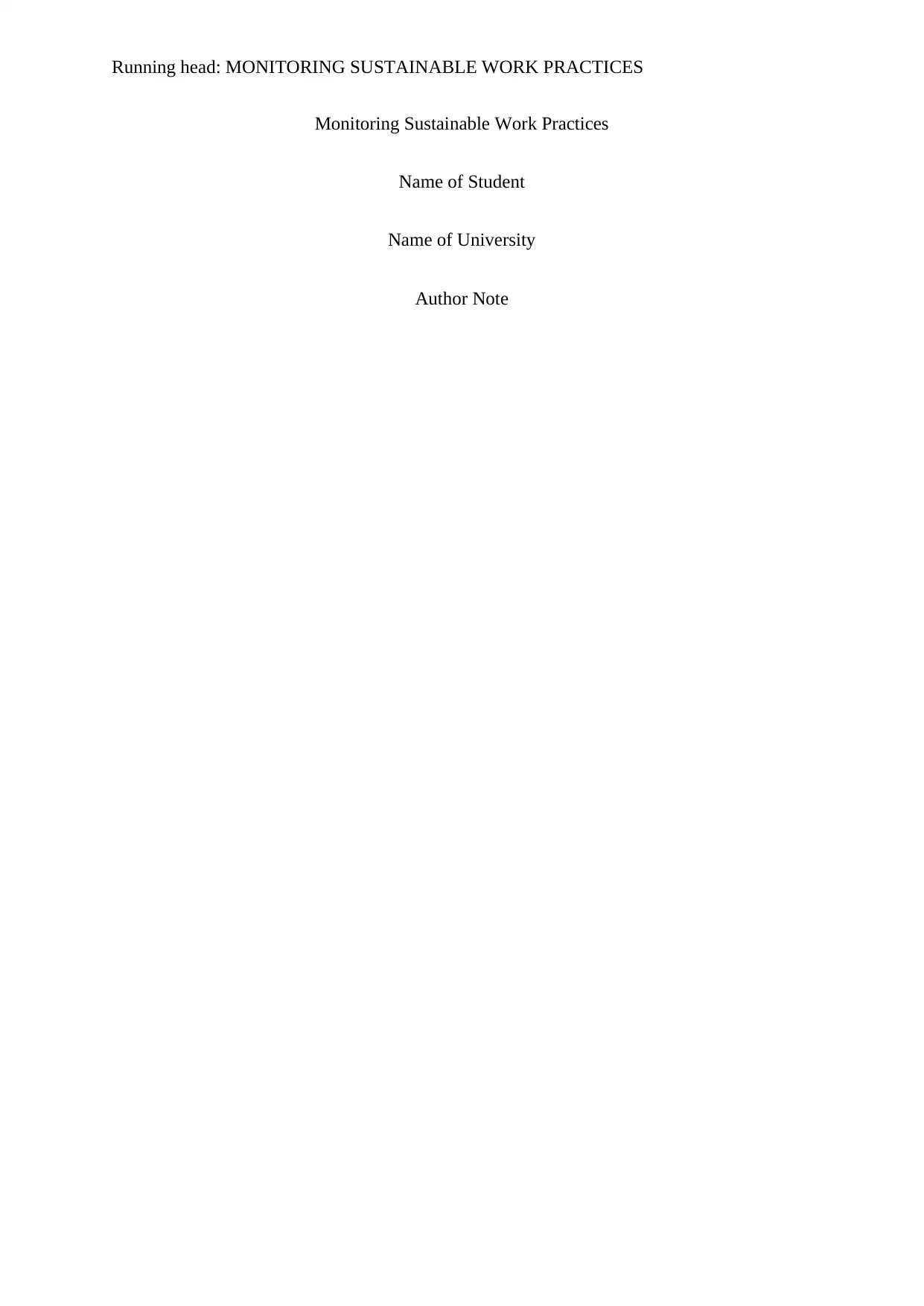
Running head: MONITORING SUSTAINABLE WORK PRACTICES
Monitoring Sustainable Work Practices
Name of Student
Name of University
Author Note
Monitoring Sustainable Work Practices
Name of Student
Name of University
Author Note
Paraphrase This Document
Need a fresh take? Get an instant paraphrase of this document with our AI Paraphraser
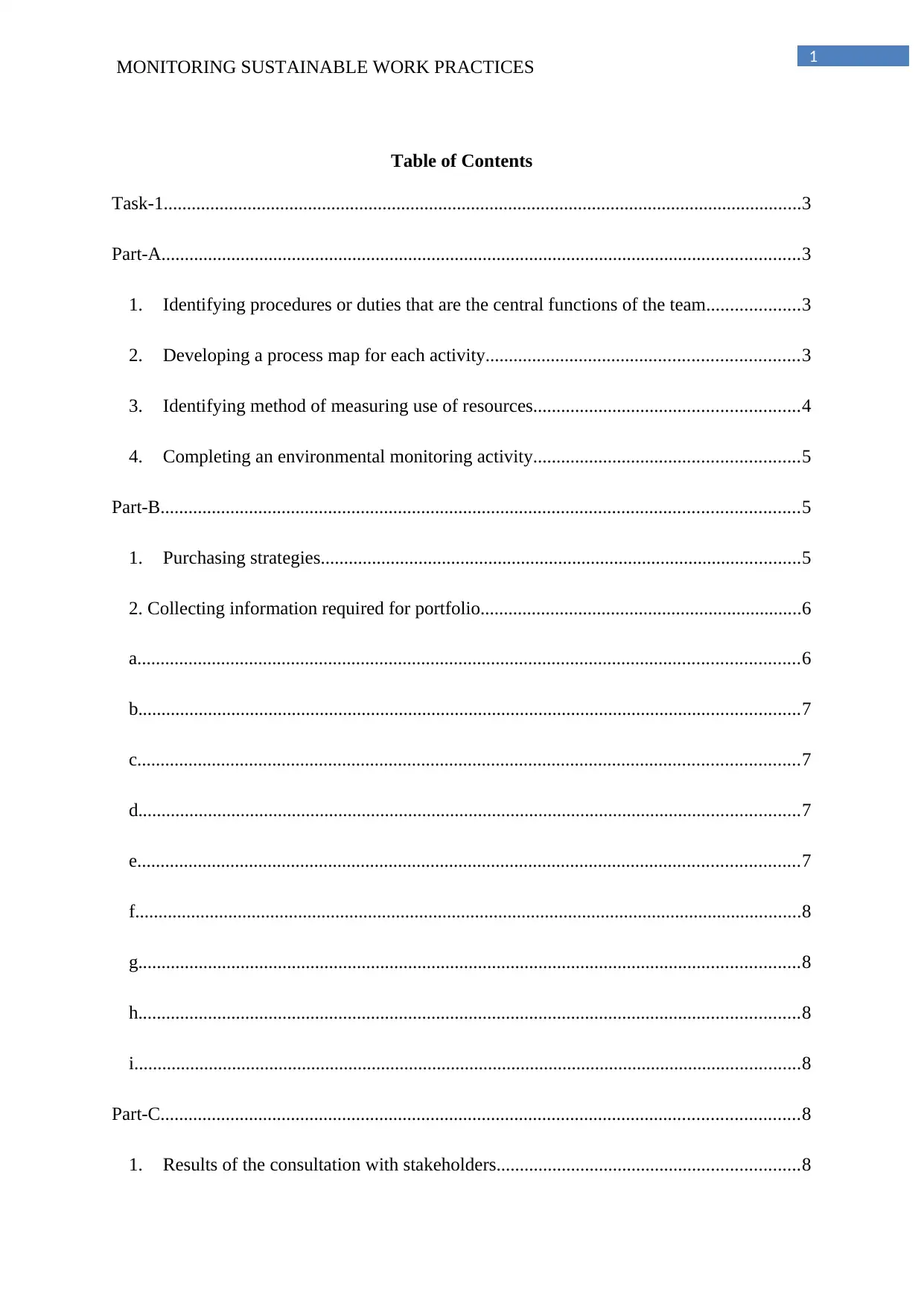
1
MONITORING SUSTAINABLE WORK PRACTICES
Table of Contents
Task-1.........................................................................................................................................3
Part-A.........................................................................................................................................3
1. Identifying procedures or duties that are the central functions of the team....................3
2. Developing a process map for each activity...................................................................3
3. Identifying method of measuring use of resources.........................................................4
4. Completing an environmental monitoring activity.........................................................5
Part-B.........................................................................................................................................5
1. Purchasing strategies.......................................................................................................5
2. Collecting information required for portfolio.....................................................................6
a..............................................................................................................................................6
b..............................................................................................................................................7
c..............................................................................................................................................7
d..............................................................................................................................................7
e..............................................................................................................................................7
f...............................................................................................................................................8
g..............................................................................................................................................8
h..............................................................................................................................................8
i...............................................................................................................................................8
Part-C.........................................................................................................................................8
1. Results of the consultation with stakeholders.................................................................8
MONITORING SUSTAINABLE WORK PRACTICES
Table of Contents
Task-1.........................................................................................................................................3
Part-A.........................................................................................................................................3
1. Identifying procedures or duties that are the central functions of the team....................3
2. Developing a process map for each activity...................................................................3
3. Identifying method of measuring use of resources.........................................................4
4. Completing an environmental monitoring activity.........................................................5
Part-B.........................................................................................................................................5
1. Purchasing strategies.......................................................................................................5
2. Collecting information required for portfolio.....................................................................6
a..............................................................................................................................................6
b..............................................................................................................................................7
c..............................................................................................................................................7
d..............................................................................................................................................7
e..............................................................................................................................................7
f...............................................................................................................................................8
g..............................................................................................................................................8
h..............................................................................................................................................8
i...............................................................................................................................................8
Part-C.........................................................................................................................................8
1. Results of the consultation with stakeholders.................................................................8
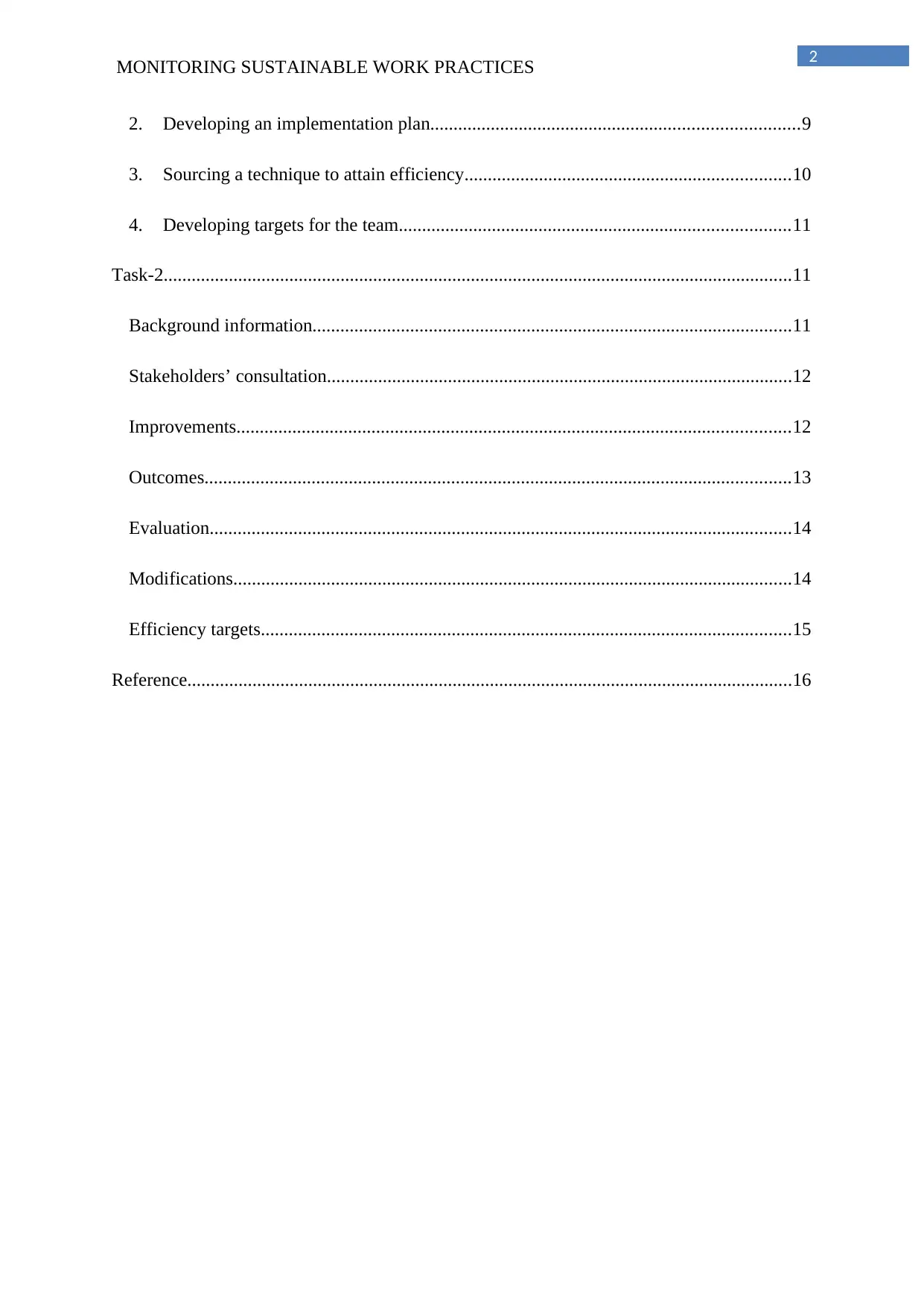
2
MONITORING SUSTAINABLE WORK PRACTICES
2. Developing an implementation plan...............................................................................9
3. Sourcing a technique to attain efficiency......................................................................10
4. Developing targets for the team....................................................................................11
Task-2.......................................................................................................................................11
Background information.......................................................................................................11
Stakeholders’ consultation....................................................................................................12
Improvements.......................................................................................................................12
Outcomes..............................................................................................................................13
Evaluation.............................................................................................................................14
Modifications........................................................................................................................14
Efficiency targets..................................................................................................................15
Reference..................................................................................................................................16
MONITORING SUSTAINABLE WORK PRACTICES
2. Developing an implementation plan...............................................................................9
3. Sourcing a technique to attain efficiency......................................................................10
4. Developing targets for the team....................................................................................11
Task-2.......................................................................................................................................11
Background information.......................................................................................................11
Stakeholders’ consultation....................................................................................................12
Improvements.......................................................................................................................12
Outcomes..............................................................................................................................13
Evaluation.............................................................................................................................14
Modifications........................................................................................................................14
Efficiency targets..................................................................................................................15
Reference..................................................................................................................................16
⊘ This is a preview!⊘
Do you want full access?
Subscribe today to unlock all pages.

Trusted by 1+ million students worldwide
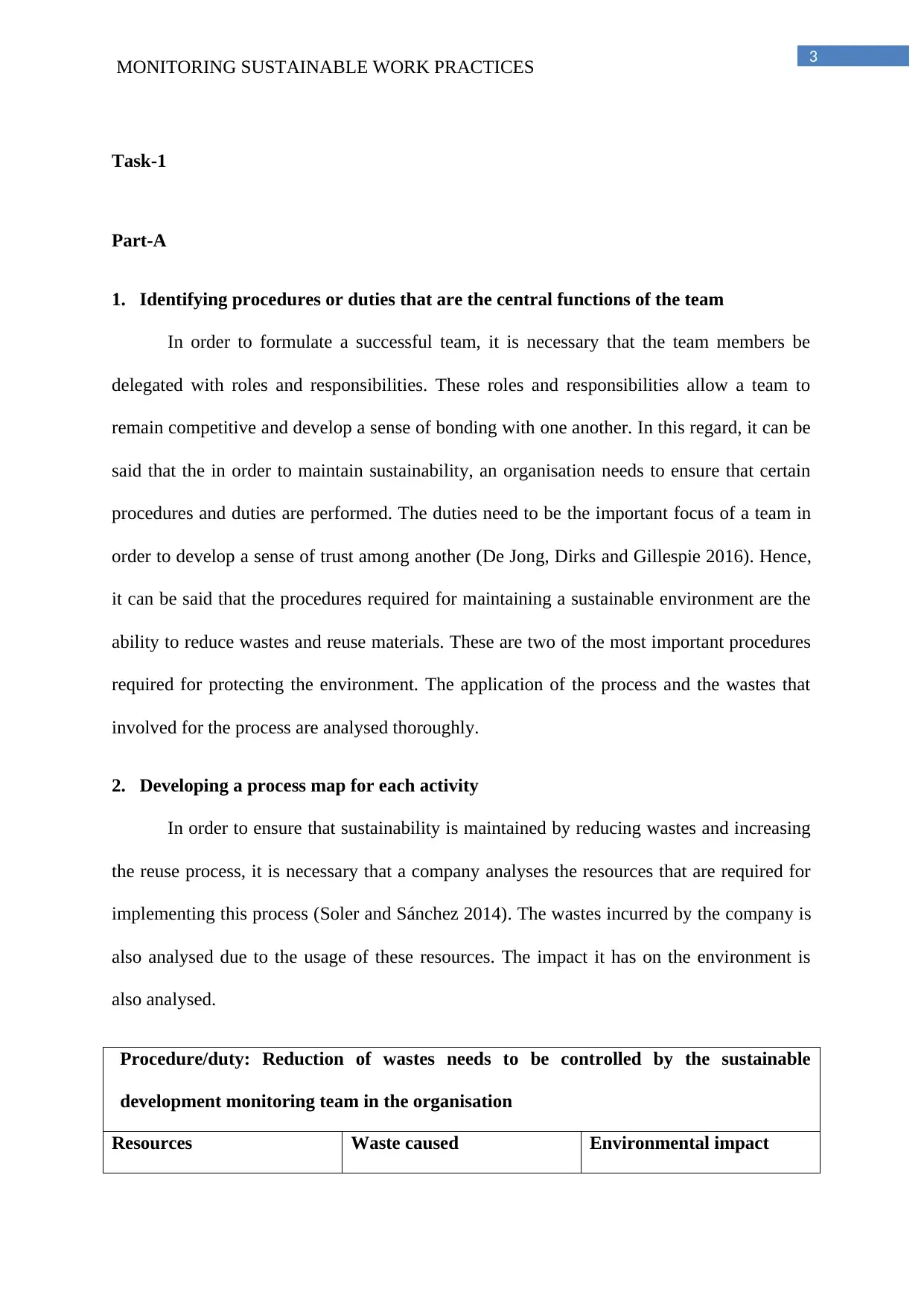
3
MONITORING SUSTAINABLE WORK PRACTICES
Task-1
Part-A
1. Identifying procedures or duties that are the central functions of the team
In order to formulate a successful team, it is necessary that the team members be
delegated with roles and responsibilities. These roles and responsibilities allow a team to
remain competitive and develop a sense of bonding with one another. In this regard, it can be
said that the in order to maintain sustainability, an organisation needs to ensure that certain
procedures and duties are performed. The duties need to be the important focus of a team in
order to develop a sense of trust among another (De Jong, Dirks and Gillespie 2016). Hence,
it can be said that the procedures required for maintaining a sustainable environment are the
ability to reduce wastes and reuse materials. These are two of the most important procedures
required for protecting the environment. The application of the process and the wastes that
involved for the process are analysed thoroughly.
2. Developing a process map for each activity
In order to ensure that sustainability is maintained by reducing wastes and increasing
the reuse process, it is necessary that a company analyses the resources that are required for
implementing this process (Soler and Sánchez 2014). The wastes incurred by the company is
also analysed due to the usage of these resources. The impact it has on the environment is
also analysed.
Procedure/duty: Reduction of wastes needs to be controlled by the sustainable
development monitoring team in the organisation
Resources Waste caused Environmental impact
MONITORING SUSTAINABLE WORK PRACTICES
Task-1
Part-A
1. Identifying procedures or duties that are the central functions of the team
In order to formulate a successful team, it is necessary that the team members be
delegated with roles and responsibilities. These roles and responsibilities allow a team to
remain competitive and develop a sense of bonding with one another. In this regard, it can be
said that the in order to maintain sustainability, an organisation needs to ensure that certain
procedures and duties are performed. The duties need to be the important focus of a team in
order to develop a sense of trust among another (De Jong, Dirks and Gillespie 2016). Hence,
it can be said that the procedures required for maintaining a sustainable environment are the
ability to reduce wastes and reuse materials. These are two of the most important procedures
required for protecting the environment. The application of the process and the wastes that
involved for the process are analysed thoroughly.
2. Developing a process map for each activity
In order to ensure that sustainability is maintained by reducing wastes and increasing
the reuse process, it is necessary that a company analyses the resources that are required for
implementing this process (Soler and Sánchez 2014). The wastes incurred by the company is
also analysed due to the usage of these resources. The impact it has on the environment is
also analysed.
Procedure/duty: Reduction of wastes needs to be controlled by the sustainable
development monitoring team in the organisation
Resources Waste caused Environmental impact
Paraphrase This Document
Need a fresh take? Get an instant paraphrase of this document with our AI Paraphraser
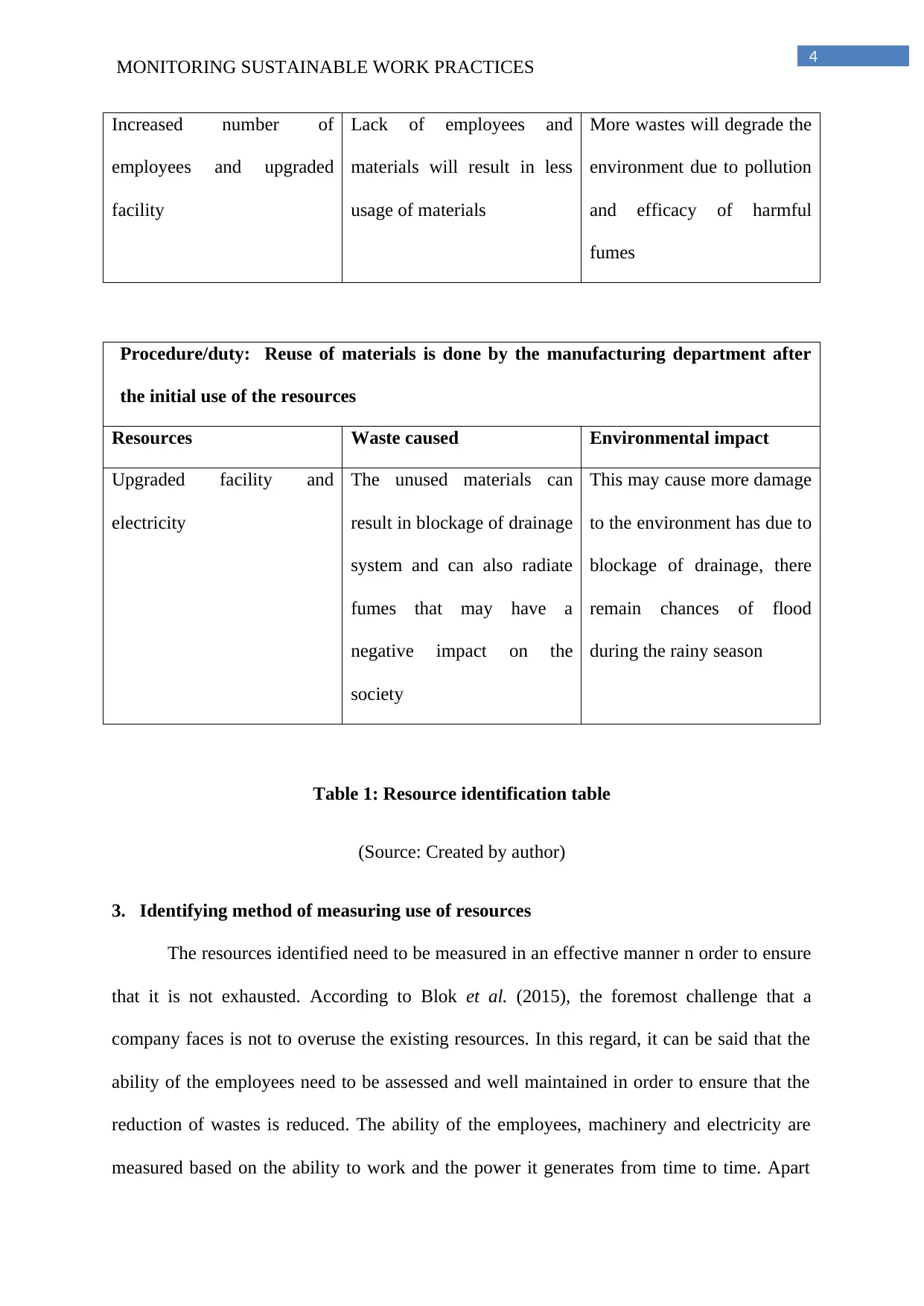
4
MONITORING SUSTAINABLE WORK PRACTICES
Increased number of
employees and upgraded
facility
Lack of employees and
materials will result in less
usage of materials
More wastes will degrade the
environment due to pollution
and efficacy of harmful
fumes
Procedure/duty: Reuse of materials is done by the manufacturing department after
the initial use of the resources
Resources Waste caused Environmental impact
Upgraded facility and
electricity
The unused materials can
result in blockage of drainage
system and can also radiate
fumes that may have a
negative impact on the
society
This may cause more damage
to the environment has due to
blockage of drainage, there
remain chances of flood
during the rainy season
Table 1: Resource identification table
(Source: Created by author)
3. Identifying method of measuring use of resources
The resources identified need to be measured in an effective manner n order to ensure
that it is not exhausted. According to Blok et al. (2015), the foremost challenge that a
company faces is not to overuse the existing resources. In this regard, it can be said that the
ability of the employees need to be assessed and well maintained in order to ensure that the
reduction of wastes is reduced. The ability of the employees, machinery and electricity are
measured based on the ability to work and the power it generates from time to time. Apart
MONITORING SUSTAINABLE WORK PRACTICES
Increased number of
employees and upgraded
facility
Lack of employees and
materials will result in less
usage of materials
More wastes will degrade the
environment due to pollution
and efficacy of harmful
fumes
Procedure/duty: Reuse of materials is done by the manufacturing department after
the initial use of the resources
Resources Waste caused Environmental impact
Upgraded facility and
electricity
The unused materials can
result in blockage of drainage
system and can also radiate
fumes that may have a
negative impact on the
society
This may cause more damage
to the environment has due to
blockage of drainage, there
remain chances of flood
during the rainy season
Table 1: Resource identification table
(Source: Created by author)
3. Identifying method of measuring use of resources
The resources identified need to be measured in an effective manner n order to ensure
that it is not exhausted. According to Blok et al. (2015), the foremost challenge that a
company faces is not to overuse the existing resources. In this regard, it can be said that the
ability of the employees need to be assessed and well maintained in order to ensure that the
reduction of wastes is reduced. The ability of the employees, machinery and electricity are
measured based on the ability to work and the power it generates from time to time. Apart
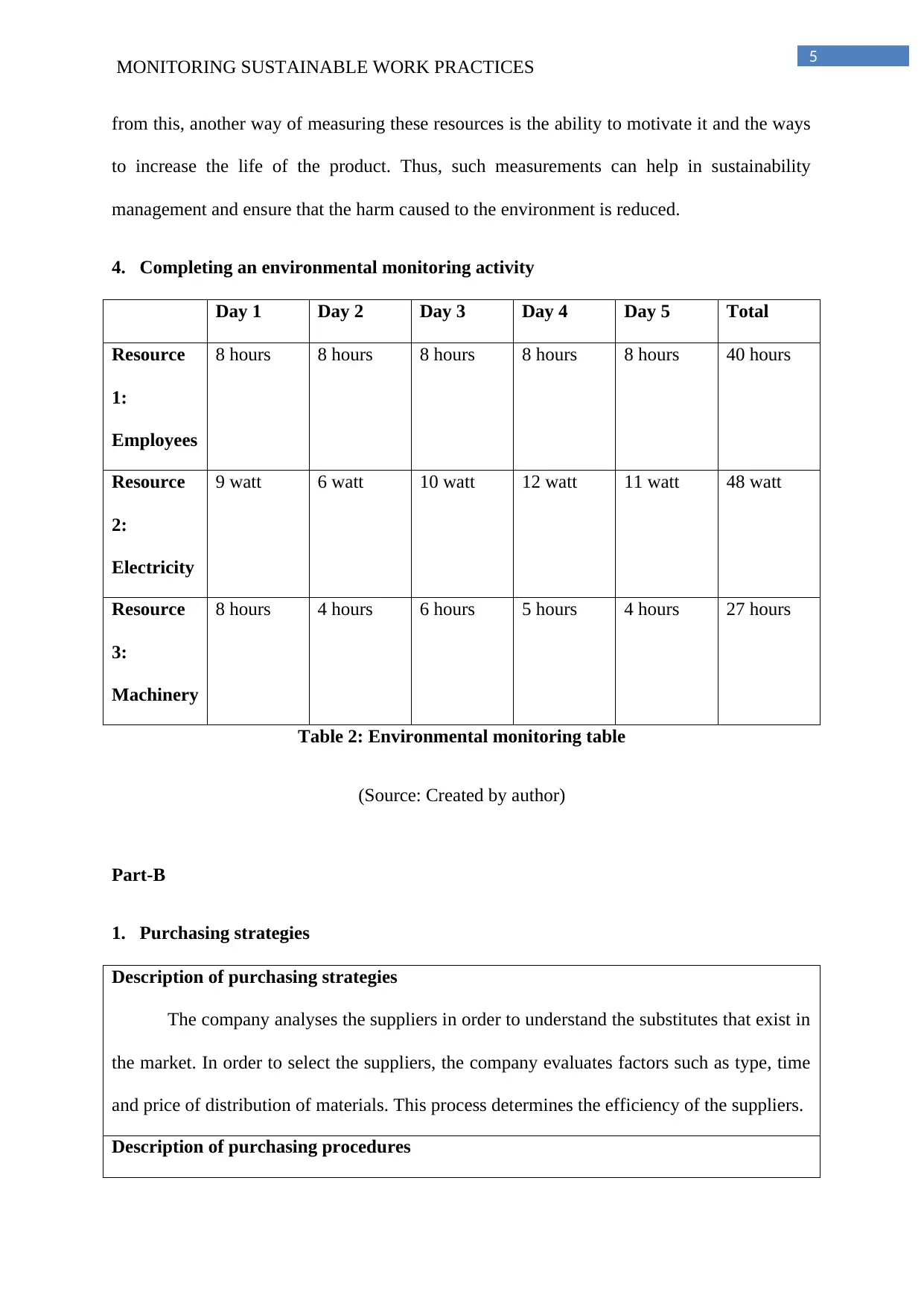
5
MONITORING SUSTAINABLE WORK PRACTICES
from this, another way of measuring these resources is the ability to motivate it and the ways
to increase the life of the product. Thus, such measurements can help in sustainability
management and ensure that the harm caused to the environment is reduced.
4. Completing an environmental monitoring activity
Day 1 Day 2 Day 3 Day 4 Day 5 Total
Resource
1:
Employees
8 hours 8 hours 8 hours 8 hours 8 hours 40 hours
Resource
2:
Electricity
9 watt 6 watt 10 watt 12 watt 11 watt 48 watt
Resource
3:
Machinery
8 hours 4 hours 6 hours 5 hours 4 hours 27 hours
Table 2: Environmental monitoring table
(Source: Created by author)
Part-B
1. Purchasing strategies
Description of purchasing strategies
The company analyses the suppliers in order to understand the substitutes that exist in
the market. In order to select the suppliers, the company evaluates factors such as type, time
and price of distribution of materials. This process determines the efficiency of the suppliers.
Description of purchasing procedures
MONITORING SUSTAINABLE WORK PRACTICES
from this, another way of measuring these resources is the ability to motivate it and the ways
to increase the life of the product. Thus, such measurements can help in sustainability
management and ensure that the harm caused to the environment is reduced.
4. Completing an environmental monitoring activity
Day 1 Day 2 Day 3 Day 4 Day 5 Total
Resource
1:
Employees
8 hours 8 hours 8 hours 8 hours 8 hours 40 hours
Resource
2:
Electricity
9 watt 6 watt 10 watt 12 watt 11 watt 48 watt
Resource
3:
Machinery
8 hours 4 hours 6 hours 5 hours 4 hours 27 hours
Table 2: Environmental monitoring table
(Source: Created by author)
Part-B
1. Purchasing strategies
Description of purchasing strategies
The company analyses the suppliers in order to understand the substitutes that exist in
the market. In order to select the suppliers, the company evaluates factors such as type, time
and price of distribution of materials. This process determines the efficiency of the suppliers.
Description of purchasing procedures
⊘ This is a preview!⊘
Do you want full access?
Subscribe today to unlock all pages.

Trusted by 1+ million students worldwide
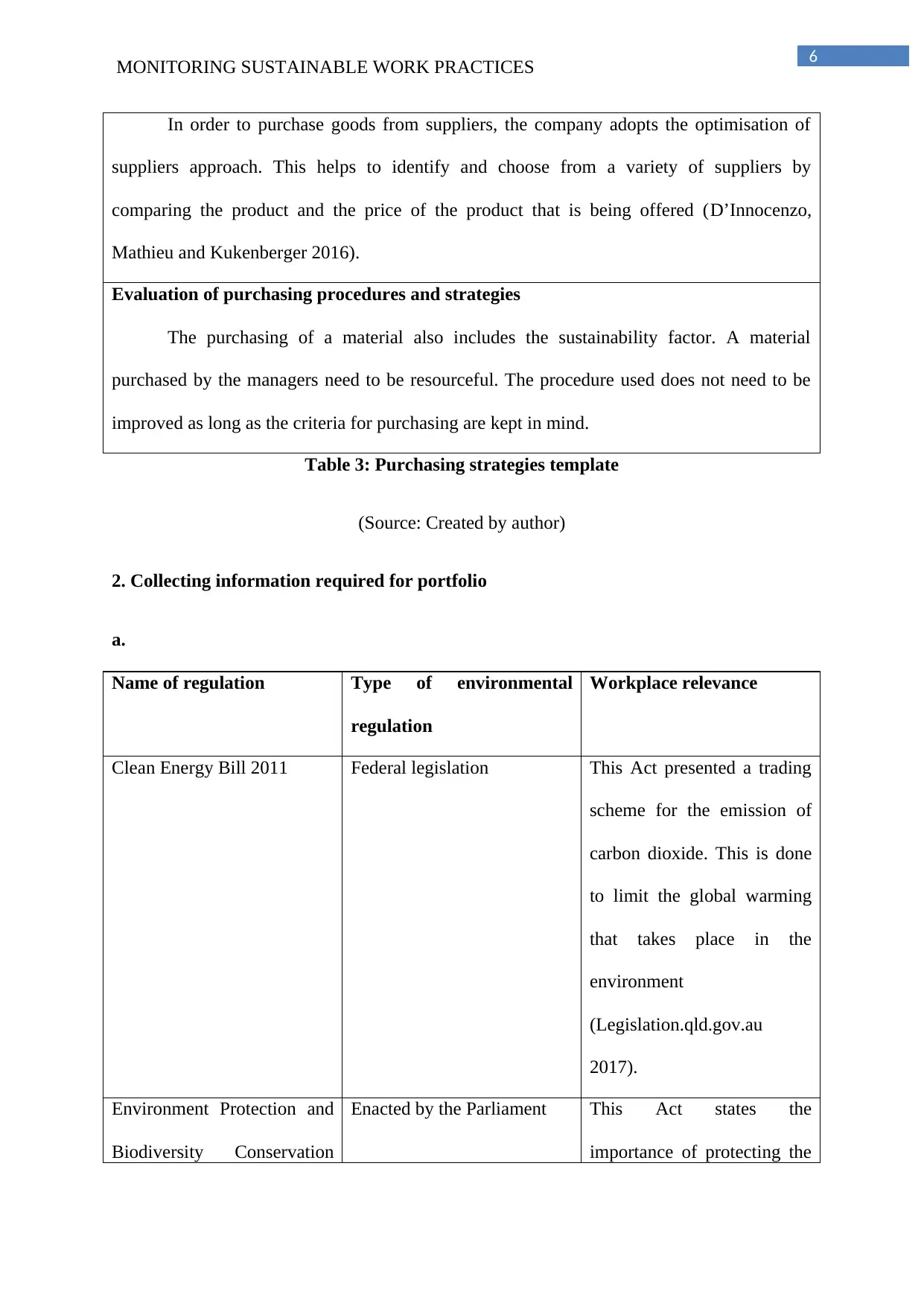
6
MONITORING SUSTAINABLE WORK PRACTICES
In order to purchase goods from suppliers, the company adopts the optimisation of
suppliers approach. This helps to identify and choose from a variety of suppliers by
comparing the product and the price of the product that is being offered (D’Innocenzo,
Mathieu and Kukenberger 2016).
Evaluation of purchasing procedures and strategies
The purchasing of a material also includes the sustainability factor. A material
purchased by the managers need to be resourceful. The procedure used does not need to be
improved as long as the criteria for purchasing are kept in mind.
Table 3: Purchasing strategies template
(Source: Created by author)
2. Collecting information required for portfolio
a.
Name of regulation Type of environmental
regulation
Workplace relevance
Clean Energy Bill 2011 Federal legislation This Act presented a trading
scheme for the emission of
carbon dioxide. This is done
to limit the global warming
that takes place in the
environment
(Legislation.qld.gov.au
2017).
Environment Protection and
Biodiversity Conservation
Enacted by the Parliament This Act states the
importance of protecting the
MONITORING SUSTAINABLE WORK PRACTICES
In order to purchase goods from suppliers, the company adopts the optimisation of
suppliers approach. This helps to identify and choose from a variety of suppliers by
comparing the product and the price of the product that is being offered (D’Innocenzo,
Mathieu and Kukenberger 2016).
Evaluation of purchasing procedures and strategies
The purchasing of a material also includes the sustainability factor. A material
purchased by the managers need to be resourceful. The procedure used does not need to be
improved as long as the criteria for purchasing are kept in mind.
Table 3: Purchasing strategies template
(Source: Created by author)
2. Collecting information required for portfolio
a.
Name of regulation Type of environmental
regulation
Workplace relevance
Clean Energy Bill 2011 Federal legislation This Act presented a trading
scheme for the emission of
carbon dioxide. This is done
to limit the global warming
that takes place in the
environment
(Legislation.qld.gov.au
2017).
Environment Protection and
Biodiversity Conservation
Enacted by the Parliament This Act states the
importance of protecting the
Paraphrase This Document
Need a fresh take? Get an instant paraphrase of this document with our AI Paraphraser
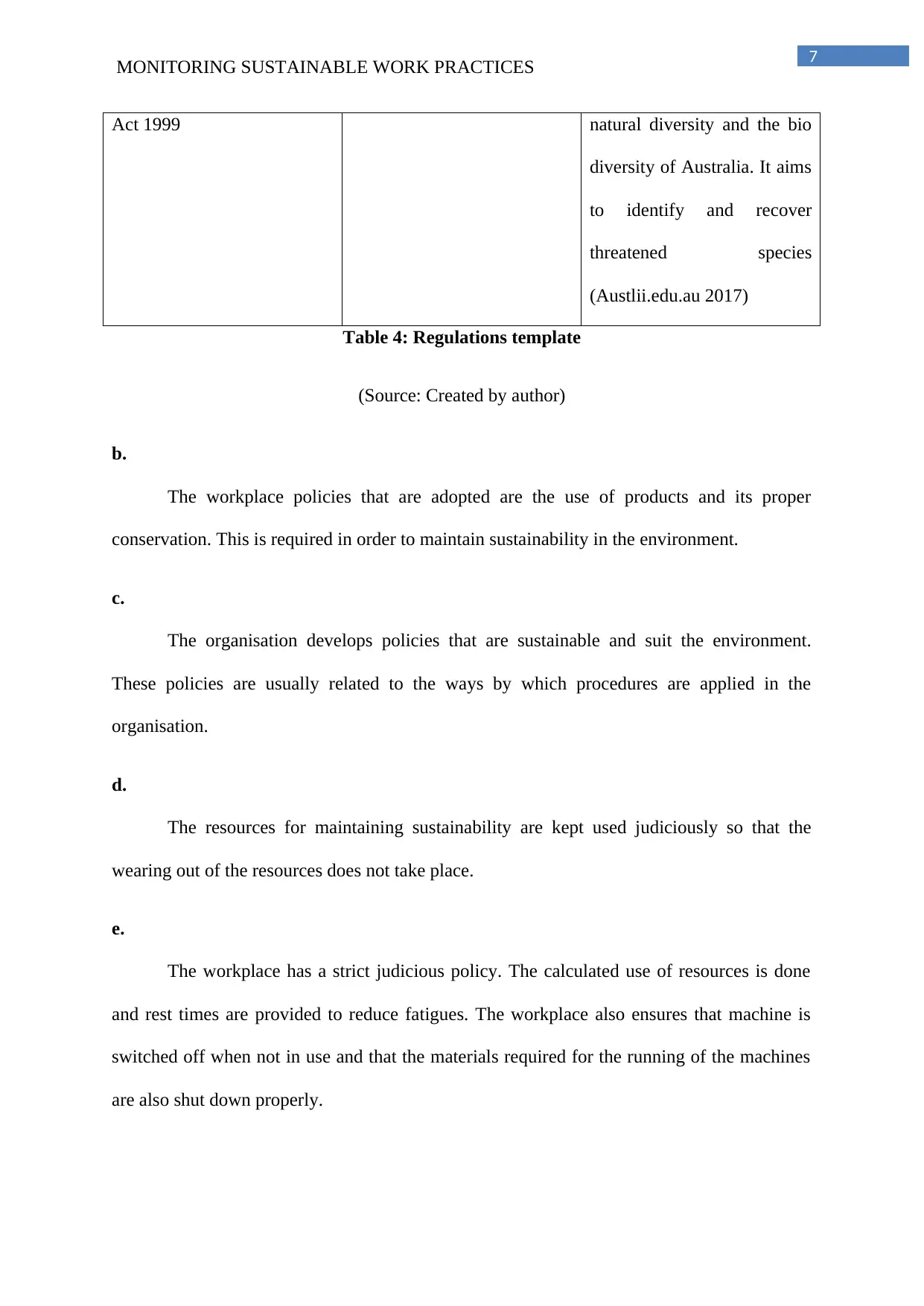
7
MONITORING SUSTAINABLE WORK PRACTICES
Act 1999 natural diversity and the bio
diversity of Australia. It aims
to identify and recover
threatened species
(Austlii.edu.au 2017)
Table 4: Regulations template
(Source: Created by author)
b.
The workplace policies that are adopted are the use of products and its proper
conservation. This is required in order to maintain sustainability in the environment.
c.
The organisation develops policies that are sustainable and suit the environment.
These policies are usually related to the ways by which procedures are applied in the
organisation.
d.
The resources for maintaining sustainability are kept used judiciously so that the
wearing out of the resources does not take place.
e.
The workplace has a strict judicious policy. The calculated use of resources is done
and rest times are provided to reduce fatigues. The workplace also ensures that machine is
switched off when not in use and that the materials required for the running of the machines
are also shut down properly.
MONITORING SUSTAINABLE WORK PRACTICES
Act 1999 natural diversity and the bio
diversity of Australia. It aims
to identify and recover
threatened species
(Austlii.edu.au 2017)
Table 4: Regulations template
(Source: Created by author)
b.
The workplace policies that are adopted are the use of products and its proper
conservation. This is required in order to maintain sustainability in the environment.
c.
The organisation develops policies that are sustainable and suit the environment.
These policies are usually related to the ways by which procedures are applied in the
organisation.
d.
The resources for maintaining sustainability are kept used judiciously so that the
wearing out of the resources does not take place.
e.
The workplace has a strict judicious policy. The calculated use of resources is done
and rest times are provided to reduce fatigues. The workplace also ensures that machine is
switched off when not in use and that the materials required for the running of the machines
are also shut down properly.
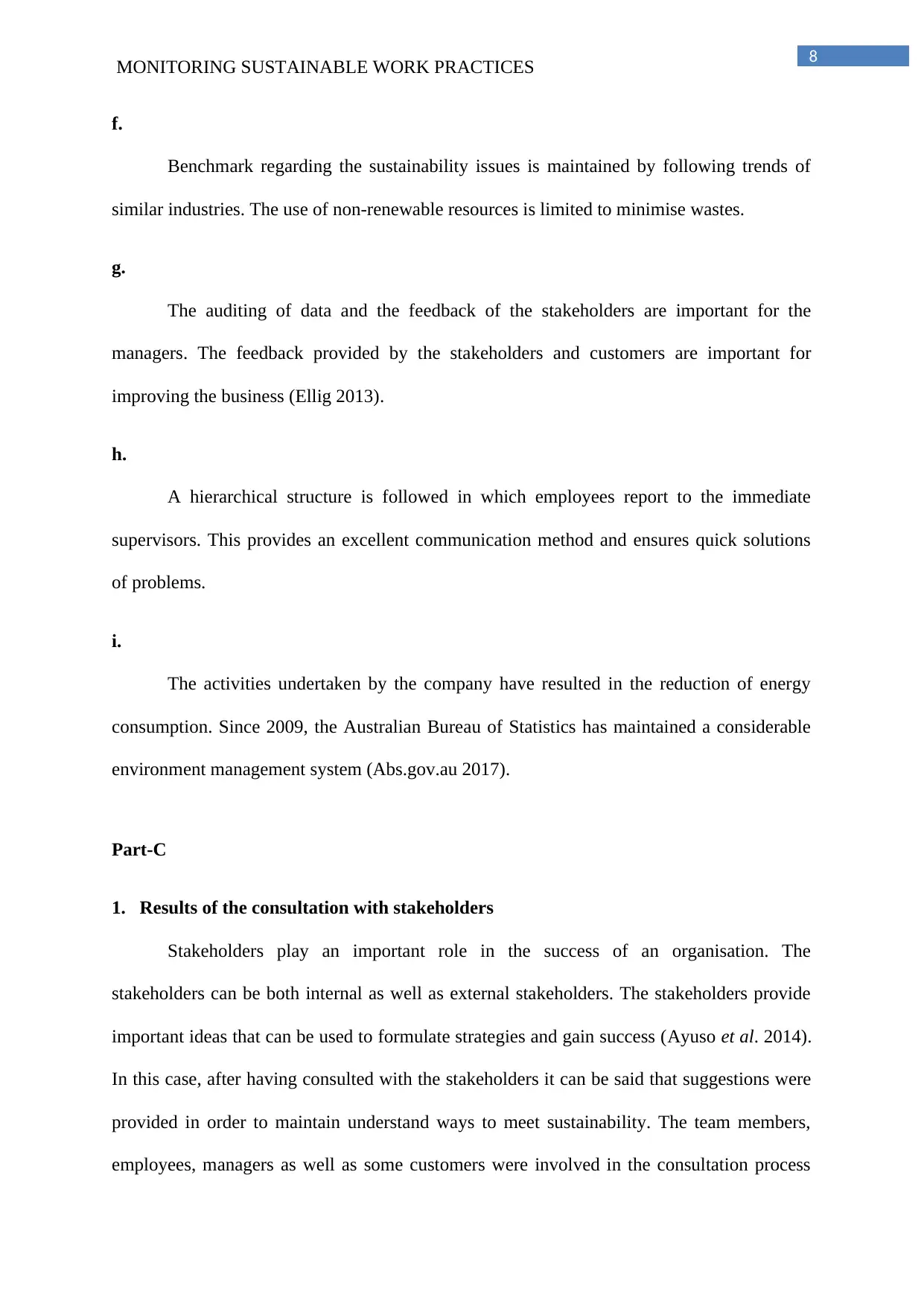
8
MONITORING SUSTAINABLE WORK PRACTICES
f.
Benchmark regarding the sustainability issues is maintained by following trends of
similar industries. The use of non-renewable resources is limited to minimise wastes.
g.
The auditing of data and the feedback of the stakeholders are important for the
managers. The feedback provided by the stakeholders and customers are important for
improving the business (Ellig 2013).
h.
A hierarchical structure is followed in which employees report to the immediate
supervisors. This provides an excellent communication method and ensures quick solutions
of problems.
i.
The activities undertaken by the company have resulted in the reduction of energy
consumption. Since 2009, the Australian Bureau of Statistics has maintained a considerable
environment management system (Abs.gov.au 2017).
Part-C
1. Results of the consultation with stakeholders
Stakeholders play an important role in the success of an organisation. The
stakeholders can be both internal as well as external stakeholders. The stakeholders provide
important ideas that can be used to formulate strategies and gain success (Ayuso et al. 2014).
In this case, after having consulted with the stakeholders it can be said that suggestions were
provided in order to maintain understand ways to meet sustainability. The team members,
employees, managers as well as some customers were involved in the consultation process
MONITORING SUSTAINABLE WORK PRACTICES
f.
Benchmark regarding the sustainability issues is maintained by following trends of
similar industries. The use of non-renewable resources is limited to minimise wastes.
g.
The auditing of data and the feedback of the stakeholders are important for the
managers. The feedback provided by the stakeholders and customers are important for
improving the business (Ellig 2013).
h.
A hierarchical structure is followed in which employees report to the immediate
supervisors. This provides an excellent communication method and ensures quick solutions
of problems.
i.
The activities undertaken by the company have resulted in the reduction of energy
consumption. Since 2009, the Australian Bureau of Statistics has maintained a considerable
environment management system (Abs.gov.au 2017).
Part-C
1. Results of the consultation with stakeholders
Stakeholders play an important role in the success of an organisation. The
stakeholders can be both internal as well as external stakeholders. The stakeholders provide
important ideas that can be used to formulate strategies and gain success (Ayuso et al. 2014).
In this case, after having consulted with the stakeholders it can be said that suggestions were
provided in order to maintain understand ways to meet sustainability. The team members,
employees, managers as well as some customers were involved in the consultation process
⊘ This is a preview!⊘
Do you want full access?
Subscribe today to unlock all pages.

Trusted by 1+ million students worldwide
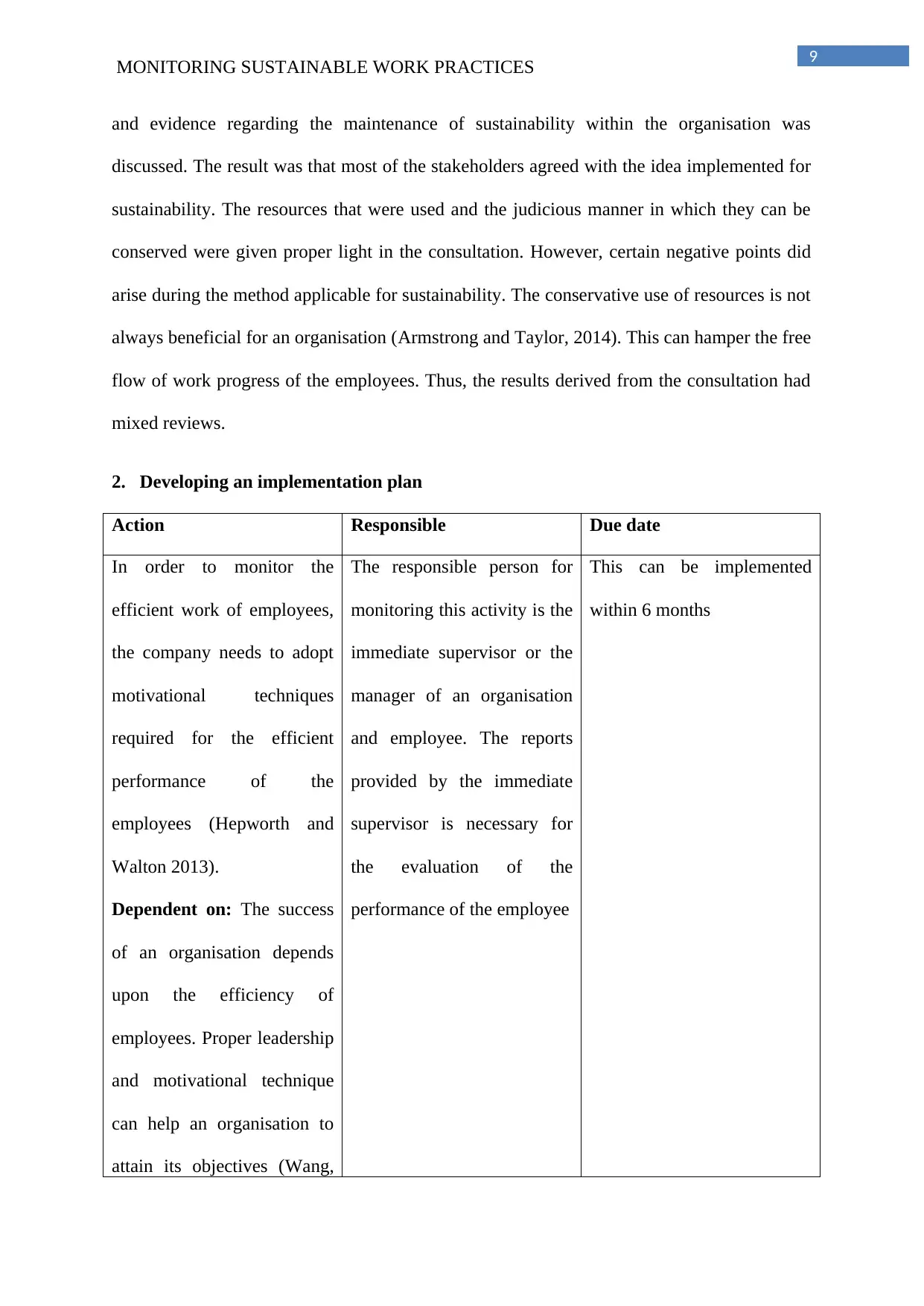
9
MONITORING SUSTAINABLE WORK PRACTICES
and evidence regarding the maintenance of sustainability within the organisation was
discussed. The result was that most of the stakeholders agreed with the idea implemented for
sustainability. The resources that were used and the judicious manner in which they can be
conserved were given proper light in the consultation. However, certain negative points did
arise during the method applicable for sustainability. The conservative use of resources is not
always beneficial for an organisation (Armstrong and Taylor, 2014). This can hamper the free
flow of work progress of the employees. Thus, the results derived from the consultation had
mixed reviews.
2. Developing an implementation plan
Action Responsible Due date
In order to monitor the
efficient work of employees,
the company needs to adopt
motivational techniques
required for the efficient
performance of the
employees (Hepworth and
Walton 2013).
Dependent on: The success
of an organisation depends
upon the efficiency of
employees. Proper leadership
and motivational technique
can help an organisation to
attain its objectives (Wang,
The responsible person for
monitoring this activity is the
immediate supervisor or the
manager of an organisation
and employee. The reports
provided by the immediate
supervisor is necessary for
the evaluation of the
performance of the employee
This can be implemented
within 6 months
MONITORING SUSTAINABLE WORK PRACTICES
and evidence regarding the maintenance of sustainability within the organisation was
discussed. The result was that most of the stakeholders agreed with the idea implemented for
sustainability. The resources that were used and the judicious manner in which they can be
conserved were given proper light in the consultation. However, certain negative points did
arise during the method applicable for sustainability. The conservative use of resources is not
always beneficial for an organisation (Armstrong and Taylor, 2014). This can hamper the free
flow of work progress of the employees. Thus, the results derived from the consultation had
mixed reviews.
2. Developing an implementation plan
Action Responsible Due date
In order to monitor the
efficient work of employees,
the company needs to adopt
motivational techniques
required for the efficient
performance of the
employees (Hepworth and
Walton 2013).
Dependent on: The success
of an organisation depends
upon the efficiency of
employees. Proper leadership
and motivational technique
can help an organisation to
attain its objectives (Wang,
The responsible person for
monitoring this activity is the
immediate supervisor or the
manager of an organisation
and employee. The reports
provided by the immediate
supervisor is necessary for
the evaluation of the
performance of the employee
This can be implemented
within 6 months
Paraphrase This Document
Need a fresh take? Get an instant paraphrase of this document with our AI Paraphraser
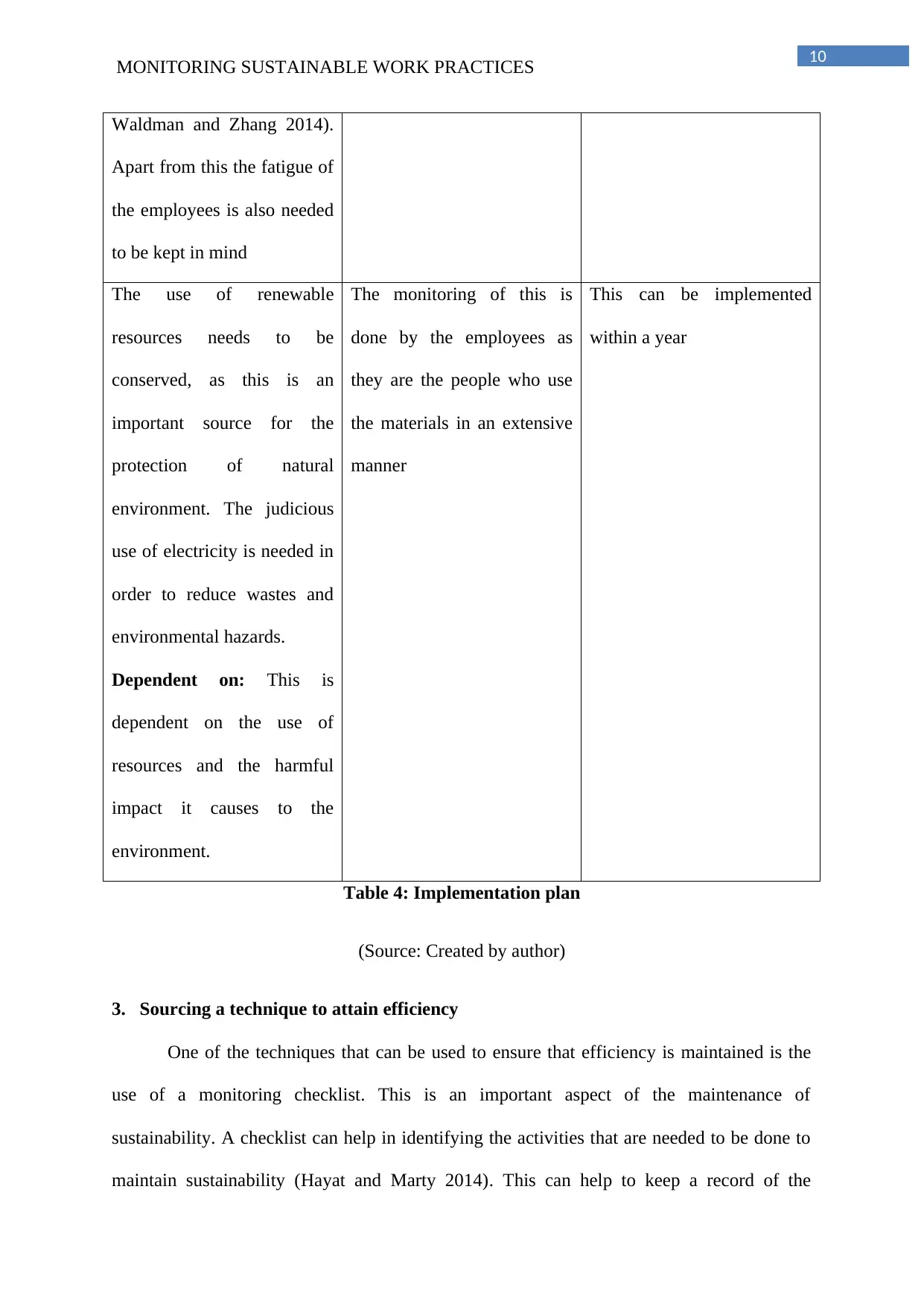
10
MONITORING SUSTAINABLE WORK PRACTICES
Waldman and Zhang 2014).
Apart from this the fatigue of
the employees is also needed
to be kept in mind
The use of renewable
resources needs to be
conserved, as this is an
important source for the
protection of natural
environment. The judicious
use of electricity is needed in
order to reduce wastes and
environmental hazards.
Dependent on: This is
dependent on the use of
resources and the harmful
impact it causes to the
environment.
The monitoring of this is
done by the employees as
they are the people who use
the materials in an extensive
manner
This can be implemented
within a year
Table 4: Implementation plan
(Source: Created by author)
3. Sourcing a technique to attain efficiency
One of the techniques that can be used to ensure that efficiency is maintained is the
use of a monitoring checklist. This is an important aspect of the maintenance of
sustainability. A checklist can help in identifying the activities that are needed to be done to
maintain sustainability (Hayat and Marty 2014). This can help to keep a record of the
MONITORING SUSTAINABLE WORK PRACTICES
Waldman and Zhang 2014).
Apart from this the fatigue of
the employees is also needed
to be kept in mind
The use of renewable
resources needs to be
conserved, as this is an
important source for the
protection of natural
environment. The judicious
use of electricity is needed in
order to reduce wastes and
environmental hazards.
Dependent on: This is
dependent on the use of
resources and the harmful
impact it causes to the
environment.
The monitoring of this is
done by the employees as
they are the people who use
the materials in an extensive
manner
This can be implemented
within a year
Table 4: Implementation plan
(Source: Created by author)
3. Sourcing a technique to attain efficiency
One of the techniques that can be used to ensure that efficiency is maintained is the
use of a monitoring checklist. This is an important aspect of the maintenance of
sustainability. A checklist can help in identifying the activities that are needed to be done to
maintain sustainability (Hayat and Marty 2014). This can help to keep a record of the
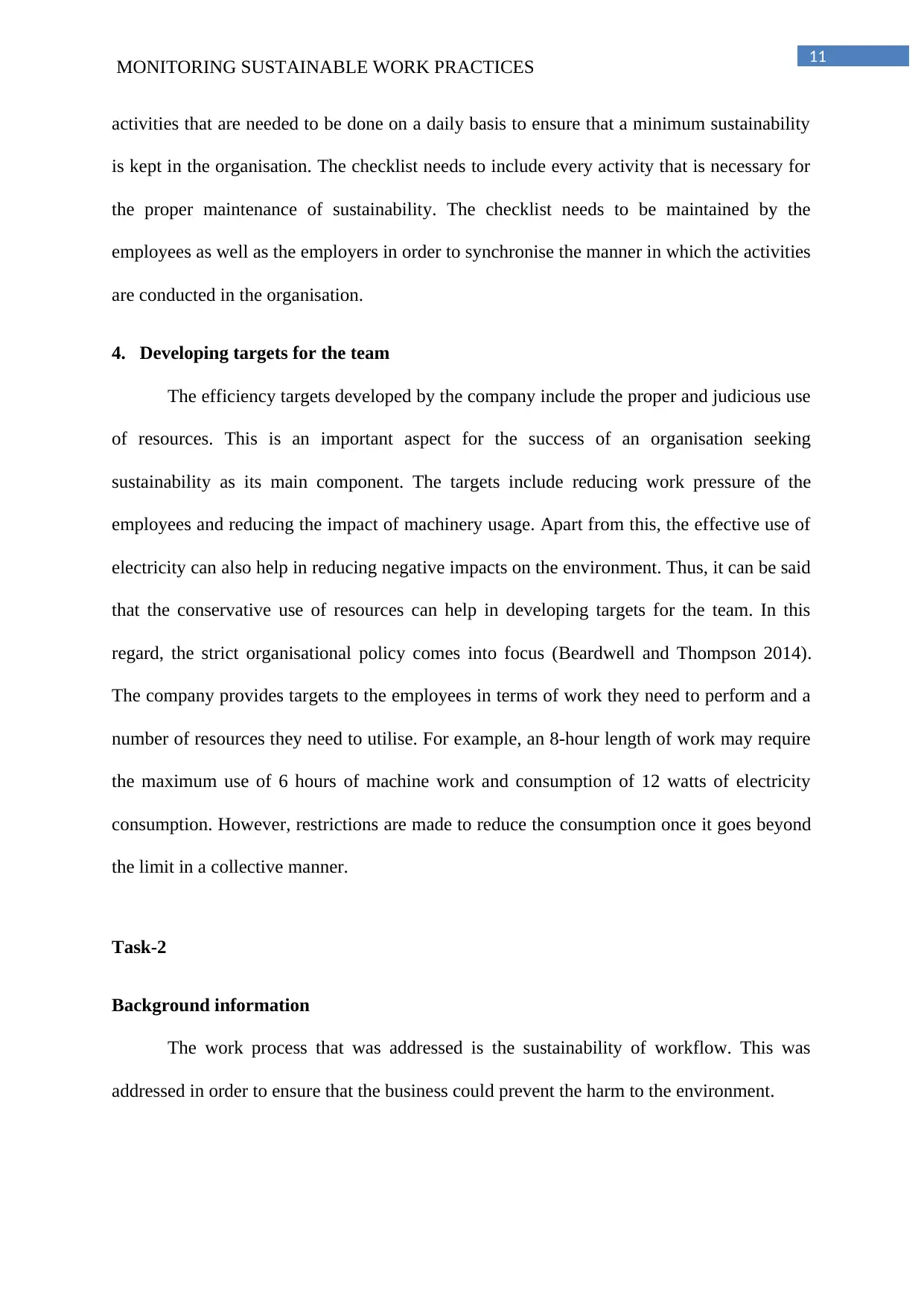
11
MONITORING SUSTAINABLE WORK PRACTICES
activities that are needed to be done on a daily basis to ensure that a minimum sustainability
is kept in the organisation. The checklist needs to include every activity that is necessary for
the proper maintenance of sustainability. The checklist needs to be maintained by the
employees as well as the employers in order to synchronise the manner in which the activities
are conducted in the organisation.
4. Developing targets for the team
The efficiency targets developed by the company include the proper and judicious use
of resources. This is an important aspect for the success of an organisation seeking
sustainability as its main component. The targets include reducing work pressure of the
employees and reducing the impact of machinery usage. Apart from this, the effective use of
electricity can also help in reducing negative impacts on the environment. Thus, it can be said
that the conservative use of resources can help in developing targets for the team. In this
regard, the strict organisational policy comes into focus (Beardwell and Thompson 2014).
The company provides targets to the employees in terms of work they need to perform and a
number of resources they need to utilise. For example, an 8-hour length of work may require
the maximum use of 6 hours of machine work and consumption of 12 watts of electricity
consumption. However, restrictions are made to reduce the consumption once it goes beyond
the limit in a collective manner.
Task-2
Background information
The work process that was addressed is the sustainability of workflow. This was
addressed in order to ensure that the business could prevent the harm to the environment.
MONITORING SUSTAINABLE WORK PRACTICES
activities that are needed to be done on a daily basis to ensure that a minimum sustainability
is kept in the organisation. The checklist needs to include every activity that is necessary for
the proper maintenance of sustainability. The checklist needs to be maintained by the
employees as well as the employers in order to synchronise the manner in which the activities
are conducted in the organisation.
4. Developing targets for the team
The efficiency targets developed by the company include the proper and judicious use
of resources. This is an important aspect for the success of an organisation seeking
sustainability as its main component. The targets include reducing work pressure of the
employees and reducing the impact of machinery usage. Apart from this, the effective use of
electricity can also help in reducing negative impacts on the environment. Thus, it can be said
that the conservative use of resources can help in developing targets for the team. In this
regard, the strict organisational policy comes into focus (Beardwell and Thompson 2014).
The company provides targets to the employees in terms of work they need to perform and a
number of resources they need to utilise. For example, an 8-hour length of work may require
the maximum use of 6 hours of machine work and consumption of 12 watts of electricity
consumption. However, restrictions are made to reduce the consumption once it goes beyond
the limit in a collective manner.
Task-2
Background information
The work process that was addressed is the sustainability of workflow. This was
addressed in order to ensure that the business could prevent the harm to the environment.
⊘ This is a preview!⊘
Do you want full access?
Subscribe today to unlock all pages.

Trusted by 1+ million students worldwide
1 out of 18
Related Documents
Your All-in-One AI-Powered Toolkit for Academic Success.
+13062052269
info@desklib.com
Available 24*7 on WhatsApp / Email
![[object Object]](/_next/static/media/star-bottom.7253800d.svg)
Unlock your academic potential
Copyright © 2020–2025 A2Z Services. All Rights Reserved. Developed and managed by ZUCOL.




